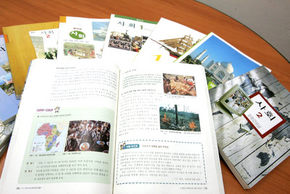 |
Disgraced researcher Hwang Woo-suk still praised in high school science texts
The scandal broke out more than a year ago. Besides his notoriously debunked assertion that his team had successfully obtained stem cells from cloned human embryos, Dr. Hwang Woo-suk claimed to have cloned a calf, named Yeongnongi, through technology called somatic cell nuclear transfer, but several investigations have failed to confirm Dr. Hwang’s claims. However, a considerable number of South Korean high school textbooks still describe Hwang’s cloned calf as fact. The Hankyoreh found the following lines in a current high school textbook: "The nation’s first cloned calf, ’Yeongnongi,’ was born. Yongnongi was born in a similar way to the cloned sheep, Dolly, and later on, the nation’s first Korean native cattle was cloned, and named ’Jin,’ " added the textbook. The book contains a chart explaining the process of Yongnongi’s "birth." Dr. Hwang, however, had unilaterally announced that he had cloned Yeongnongi without producing any proof. Moreover, the task of trying to authenticate Hwang’s claims of successful somatic cell cloning proved controversial. Two local news networks had a research center test samples given by Dr. Hwang in order to verify Yeongnongi’s origins, but the results were inconclusive. Later, an Seoul National University committee that investigated Dr. Hwang’s stem cell research papers said, "As the ’mother’ cow that was said to provide the cells was already dead, it is impossible to confirm the authenticity of Yongnongi’s cloning." According to an official at the Ministry of Education and Human Resources Development, all textbook sections with references to Dr. Hwang’s work were removed from elementary, middle, and high school textbooks earlier this year, but parts related to the cloned calf were not included on the list of sections to be revised."In 1996, a cow named ’Borami’ that produces Lactoferrin, a glycoprotein found in human breast milk, was born in Korea," reads another textbook, referring to claims by the Korea Research Institute of Bioscience & Biotechnology. "Borami will be able to mass-produce human Lactoferrin." The same book writes, "In a similar way, a pig named ’Saeromi’ was born to produce treatment for anemia," which was a claim by South Korea’s National Livestock Research Institute. "Saeromi produces milk containing the treatment enzyme," the book announces. But both Borami and Saeromi are male, however, which means that they lack the capability to produce any milk, special or otherwise. In fact, it was not Borami and Saeromi but their female offspring that were supposed to yield the special milk enzymes. The offspring, however, were proven in 2002 to be unable to produce sufficient amounts for medical use. Another textbook says that "in November 2001, it was finally announced that a human embryo was successfully cloned," referring to Hwang’s claim. This was not yet confirmed, however, cautions the book.





